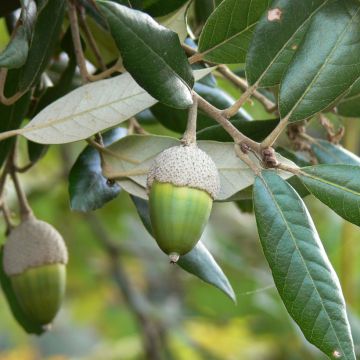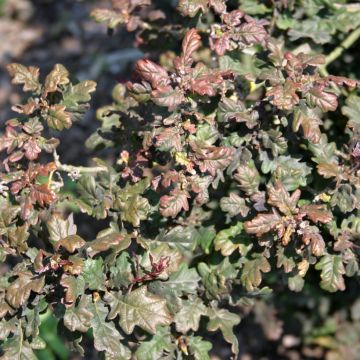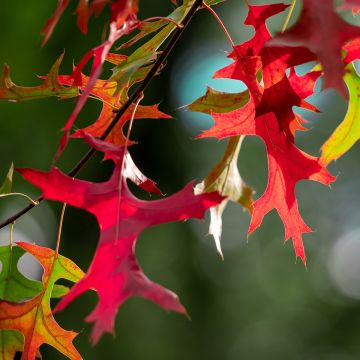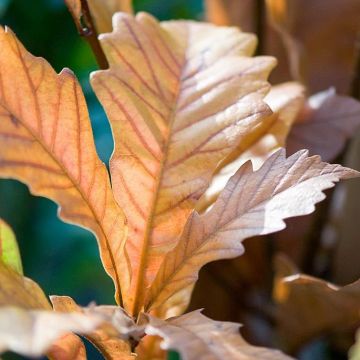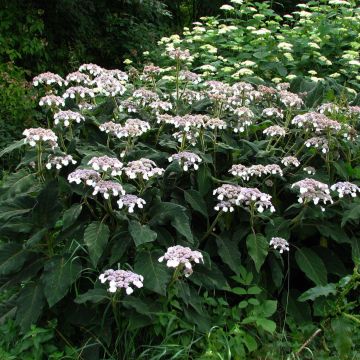

Quercus x warei Nadler - Oak
Quercus x warei Nadler - Oak
Quercus x warei 'Nadler' Kindred Spirit®
Oak
Why not try an alternative variety in stock?
View all →This plant carries a 24 months recovery warranty
More information
We guarantee the quality of our plants for a full growing cycle, and will replace at our expense any plant that fails to recover under normal climatic and planting conditions.
Oversize package: home delivery by special carrier from €6.90 per order..
Express home delivery from €8.90.
Does this plant fit my garden?
Set up your Plantfit profile →
Description
Quercus x warei 'Nadler' or Kindred Spirit is a remarkable hybrid oak tree known for its very columnar habit and exceptional robustness. This slender tree is appreciated for its tolerance to difficult conditions and its ornamental qualities, particularly its beautiful dark green leaves with a silver underside and its autumn colours. Suitable for medium to large gardens, it is perfect for structuring the space while adding a touch of elegance. This tree is hardy, resistant to wind and disease, and thrives in any deep, moist to dry soil.
Belonging to the Fagaceae family, Quercus x warei 'Kindred Spirit' is a cultivar obtained in 2005 by Earl Cully Nursery in Jacksonville, Illinois, USA. Resulting from the hybridisation between Quercus robur ‘Fastigiata’ and Q. bicolour, this oak combines the best characteristics of its parents. With rapid growth, it reaches a height of 10 to 15 m and a width of 3 to 5 m. Its branches are upright and form a very dense, narrow, and slender crown. Its young branches are brown-grey. The mature bark is composed of dark to light gray rectangular blocks. The leaves of the 'Kindred Spirit' oak, larger than those of Quercus robur, are ovate and lobed, a shiny dark green colour with a silver underside. They take on shades of brownish-yellow and bronze in autumn and remain on the branches for quite some time before falling off. The flowering, in May, takes the form of greenish-yellow catkins measuring 4.5 to 8 cm in length. Despite being a hybrid, this oak produces acorns. The 2 to 3 cm long acorns usually form in pairs, with one of the two often being underdeveloped. About half of the acorn is surrounded by a cupule covered with trigonous scales. The root system of this tree is deep and powerful, being both taproot and extensively spreading, ensuring a solid and long-lasting anchorage in deep soils.
The 'Kindred Spirit' hybrid oak is particularly resistant to diseases, including powdery mildew, and tolerates wind, drought once established and clayey and saline soils. It is hardy down to -28°C, allowing it to adapt to a wide range of climates and growing conditions.
The 'Kindred Spirit' oak can be used to form tall hedges and create green screens. It can also be planted in small groups or as a standalone specimen. It adapts perfectly to urban environments. It can be associated with Cornus mas (Cornelian cherry), Acer campestre (Field maple), Carpinus betulus (European hornbeam), and Prunus laurocerasus 'Greentorch' (Cherry laurel). At its base, a robust ground cover such as the variegated greater periwinkle Vinca major 'Variegata' can be planted. This oak also has the advantage of producing abundant leaf litter, which is beneficial for the growth of certain plants. And its fruits provide food for small animals like squirrels and jays.
Report an error about the product description
Plant habit
Flowering
Foliage
Botanical data
Quercus
x warei
'Nadler' Kindred Spirit®
Fagaceae
Oak
Quercus x warei KINDRED SPIRIT, Quercus x warei Nadler
Cultivar or hybrid
Other Oak
Planting and care
Quercus x warei 'Nadler' grows in ordinary, but deep, moist soil that is slightly alkaline, neutral, or slightly acidic. It prefers clayey soils, but can adapt easily to other types of soil. Once established, this tree with deep roots can tolerate normal summers, even fairly dry ones, and does not require watering. This oak thrives in most areas. It appreciates slightly moist, well-drained soils, where its growth will be faster. It prefers very sunny and open exposures. Place a sturdy stake to help it establish, follow watering guidelines, and then let nature take its course. Once established, this tree requires very little maintenance, apart from removing dead wood. It is not prone to diseases and is resistant to powdery mildew.
Planting period
Intended location
Care
This item has not been reviewed yet - be the first to leave a review about it.
Striking foliage shrubs
Haven't found what you were looking for?
Hardiness is the lowest winter temperature a plant can endure without suffering serious damage or even dying. However, hardiness is affected by location (a sheltered area, such as a patio), protection (winter cover) and soil type (hardiness is improved by well-drained soil).

Photo Sharing Terms & Conditions
In order to encourage gardeners to interact and share their experiences, Promesse de fleurs offers various media enabling content to be uploaded onto its Site - in particular via the ‘Photo sharing’ module.
The User agrees to refrain from:
- Posting any content that is illegal, prejudicial, insulting, racist, inciteful to hatred, revisionist, contrary to public decency, that infringes on privacy or on the privacy rights of third parties, in particular the publicity rights of persons and goods, intellectual property rights, or the right to privacy.
- Submitting content on behalf of a third party;
- Impersonate the identity of a third party and/or publish any personal information about a third party;
In general, the User undertakes to refrain from any unethical behaviour.
All Content (in particular text, comments, files, images, photos, videos, creative works, etc.), which may be subject to property or intellectual property rights, image or other private rights, shall remain the property of the User, subject to the limited rights granted by the terms of the licence granted by Promesse de fleurs as stated below. Users are at liberty to publish or not to publish such Content on the Site, notably via the ‘Photo Sharing’ facility, and accept that this Content shall be made public and freely accessible, notably on the Internet.
Users further acknowledge, undertake to have ,and guarantee that they hold all necessary rights and permissions to publish such material on the Site, in particular with regard to the legislation in force pertaining to any privacy, property, intellectual property, image, or contractual rights, or rights of any other nature. By publishing such Content on the Site, Users acknowledge accepting full liability as publishers of the Content within the meaning of the law, and grant Promesse de fleurs, free of charge, an inclusive, worldwide licence for the said Content for the entire duration of its publication, including all reproduction, representation, up/downloading, displaying, performing, transmission, and storage rights.
Users also grant permission for their name to be linked to the Content and accept that this link may not always be made available.
By engaging in posting material, Users consent to their Content becoming automatically accessible on the Internet, in particular on other sites and/or blogs and/or web pages of the Promesse de fleurs site, including in particular social pages and the Promesse de fleurs catalogue.
Users may secure the removal of entrusted content free of charge by issuing a simple request via our contact form.
The flowering period indicated on our website applies to countries and regions located in USDA zone 8 (France, the United Kingdom, Ireland, the Netherlands, etc.)
It will vary according to where you live:
- In zones 9 to 10 (Italy, Spain, Greece, etc.), flowering will occur about 2 to 4 weeks earlier.
- In zones 6 to 7 (Germany, Poland, Slovenia, and lower mountainous regions), flowering will be delayed by 2 to 3 weeks.
- In zone 5 (Central Europe, Scandinavia), blooming will be delayed by 3 to 5 weeks.
In temperate climates, pruning of spring-flowering shrubs (forsythia, spireas, etc.) should be done just after flowering.
Pruning of summer-flowering shrubs (Indian Lilac, Perovskia, etc.) can be done in winter or spring.
In cold regions as well as with frost-sensitive plants, avoid pruning too early when severe frosts may still occur.
The planting period indicated on our website applies to countries and regions located in USDA zone 8 (France, United Kingdom, Ireland, Netherlands).
It will vary according to where you live:
- In Mediterranean zones (Marseille, Madrid, Milan, etc.), autumn and winter are the best planting periods.
- In continental zones (Strasbourg, Munich, Vienna, etc.), delay planting by 2 to 3 weeks in spring and bring it forward by 2 to 4 weeks in autumn.
- In mountainous regions (the Alps, Pyrenees, Carpathians, etc.), it is best to plant in late spring (May-June) or late summer (August-September).
The harvesting period indicated on our website applies to countries and regions in USDA zone 8 (France, England, Ireland, the Netherlands).
In colder areas (Scandinavia, Poland, Austria...) fruit and vegetable harvests are likely to be delayed by 3-4 weeks.
In warmer areas (Italy, Spain, Greece, etc.), harvesting will probably take place earlier, depending on weather conditions.
The sowing periods indicated on our website apply to countries and regions within USDA Zone 8 (France, UK, Ireland, Netherlands).
In colder areas (Scandinavia, Poland, Austria...), delay any outdoor sowing by 3-4 weeks, or sow under glass.
In warmer climes (Italy, Spain, Greece, etc.), bring outdoor sowing forward by a few weeks.

































